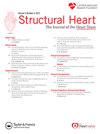Staging Aortic Stenosis Based on Cardiac Damage: A New Tool for Risk Prediction, Clinical Decision-Making, and Trial Design
IF 2.8
Q3 CARDIAC & CARDIOVASCULAR SYSTEMS
引用次数: 0
Abstract
Staging based on extra-valvular cardiac damage is an intuitive approach to categorizing patients with aortic stenosis (AS) that is easily applied using widely available echocardiographic tools. As discussed in this review, it has been shown to be a powerful tool for risk stratification that complements conventional approaches. The original and most widely used framework identifies stage 0 when there is AS without additional cardiac damage; stage 1 when there is left ventricular damage (hypertrophy, systolic or diastolic dysfunction with evidence of elevated filling pressures); stage 2 when there is mitral dysfunction (moderate or greater mitral regurgitation, typically secondary) or left atrial abnormalities (left atrial enlargement or atrial fibrillation); stage 3 when there is pulmonary hypertension and/or moderate or greater tricuspid regurgitation (typically secondary); and stage 4 when there is moderate or greater right ventricular dysfunction. In a series of studies that have collectively evaluated damage before and after aortic valve replacement in patients with moderate and severe AS, as well as with and without symptoms, cardiac damage has been shown to predict all-cause and cardiovascular mortality and other outcomes. These observations support the design of trials to reevaluate thresholds for aortic valve replacement in AS and approaches that consider cardiac damage stage in clinical decision-making for individual patients (valve replacement vs. medical therapy).
基于心脏损伤的主动脉瓣狭窄分期:风险预测、临床决策和试验设计的新工具
基于瓣外心脏损伤的分期是对主动脉瓣狭窄(AS)患者进行分类的一种直观的方法,很容易应用于广泛可用的超声心动图工具。正如本综述所讨论的那样,它已被证明是一种有效的风险分层工具,可以补充传统方法。最初和最广泛使用的框架将AS定义为0期,即没有额外的心脏损伤;第1期:左室损伤(肥厚、收缩或舒张功能不全,充盈压力升高);2期:二尖瓣功能不全(中度或重度二尖瓣反流,通常继发性)或左房异常(左房增大或心房颤动);第3期:肺动脉高压和/或中度或更严重的三尖瓣反流(通常为继发性);第四阶段是中度或更严重的右心室功能不全。在一系列研究中,这些研究集体评估了中度和重度AS患者主动脉瓣置换术前后的损伤,以及有无症状,心脏损伤已被证明可以预测全因死亡率和心血管死亡率以及其他结果。这些观察结果支持重新评估AS患者主动脉瓣置换术阈值的试验设计,以及在个体患者的临床决策中考虑心脏损伤阶段的方法(瓣膜置换术与药物治疗)。
本文章由计算机程序翻译,如有差异,请以英文原文为准。
求助全文
约1分钟内获得全文
求助全文
来源期刊

Structural Heart
Medicine-Cardiology and Cardiovascular Medicine
CiteScore
1.60
自引率
0.00%
发文量
81
 求助内容:
求助内容: 应助结果提醒方式:
应助结果提醒方式:


